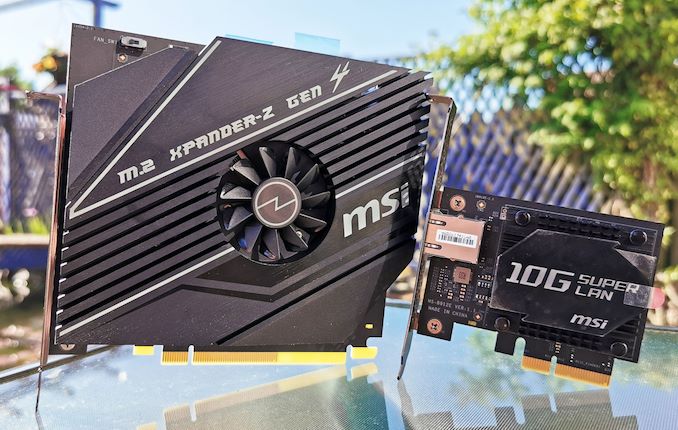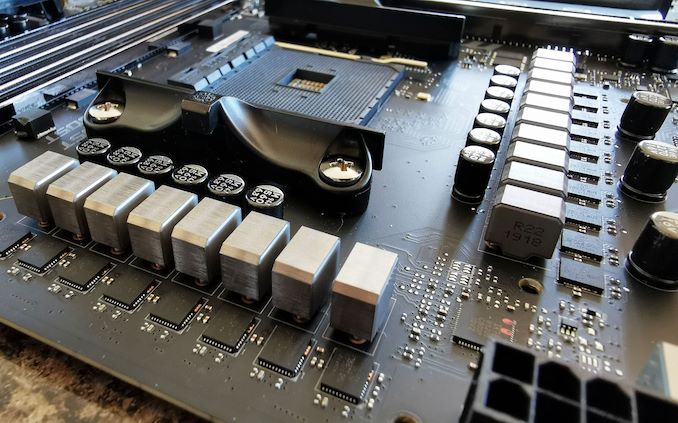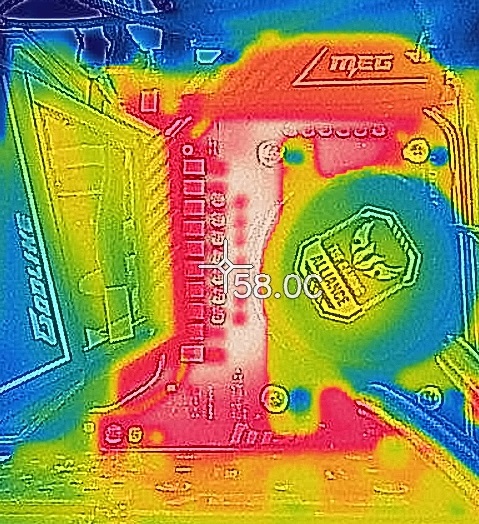The MSI MEG X570 Godlike Motherboard Review: Thor's Flagship
by Gavin Bonshor on August 28, 2019 12:00 PM EST- Posted in
- Motherboards
- AMD
- MSI
- 10G Ethernet
- Ryzen
- PCIe 4.0
- Ryzen 3000
- X570
- X570 Godlike
- MEG
MSI MEG X570 Godlike Conclusion
The MSI MEG X570 Godlike is an E-ATX motherboard which sits at the top of MSI's X570 product stack. It has a current price tag of $700 which puts it as one of the most expensive X570 models so far, and on paper it is one of the most feature-packed of all the X570 models. Other models that compete with this in terms of price point are the ASUS ROG Crosshair VIII Formula ($700), and the GIGABYTE X570 Aorus Xtreme ($700).
On offer is four full-length PCIe 4.0 slots which operate at x16, x8/x0/x8, and x8/x4/x4, while the bottom slot is locked to PCIe 4.0 x4. The MSI MEG X570 Godlike is the only X570 model with four full-length slots and as a consequence, has no PCIe 4.0 x1 slots. Its storage capabilities are also impressive with three PCIe 4.0 x4 M.2 slots on the board, with two additional PCIe 4.0 x4 drives due to the Xpander-Z Gen4 add-on card in the accessories bundle. On top of this, there are six SATA ports with support for RAID 0, 1, and 10 arrays.
Not only is the rear panel heavily packed with connections including three USB 3.1 G2 Type-A, one USB 3.1 G2 Type-C, and two USB 3.0 G1 Type-A ports, but the accessories bundle is also comprehensive with an Aquantia AQC107 10 G Super LAN card included; the other notable inclusion is six red and black braided SATA cables. Also included on the rear panel is a Flash BIOS and clear CMOS button which are very handy to have. A trio of Killer Networking powered ports including two Ethernet ports powered by an E3000 2.5 G and E2600 Gigabit NIC, but there is also an AX1650 Wi-Fi 6 802.11ax wireless interface which provides users with BT 5.0 connectivity too. Onboard audio is also boosted by the inclusion of an ESS 9018 Sabre DAC driven 6.3 mm headphone output, with a Realtek ALC1220 codec each for the front panel audio connector, and the five 3.5 mm jacks and S/PDIF optical output.
A reoccurring theme throughout the analysis of the MSI MEG X570 Godlike is the quality of the componentry, and its 16-phase power delivery as impressive as any board MSI has released over the last five years. The power delivery is using an International Rectifier IR35201 running at 7+1, with fourteen TDA21472 70 A power stages doubled up with seven IR3599 doublers. On the SoC section, there are four TDA21472 70 A power stages which are interestingly operating from a single IR3599 doubler running in quad mode; not exactly why MSI is using four power stages for the SOC when just two would have been suitable. The MSI X570 Godlike also boasts an impressive number of 4-pin fan headers with a total of nine splits into one for a CPU fan, one for a water pump, and seven for chassis fans.
On the performance front, the MSI MEG X570 Godlike performed consistently well throughout our CPU and gaming test suites. Power consumption was interesting in our testing with consistently higher than normal power draw in both idle and long idle power states, but matched other boards at peak load. This high idle power is likely due to the sheer number of controllers onboard.At full load, it performed on par with the MSI MEG X570 Ace which either shows the inefficiency of MSI's models at full-load; for reference, the ASUS Pro WS X570-Ace was a good 8 Watts better off at full load.

The MSI MEG X570 Godlike has an impressive accessories bundle
The overclocking performance was fruitful when done manually, with the 14-phase CPU power delivery and firmware doing its job well. MSI's Game Boost overclocking profiles on the other hand in our testing proved woefully inept with very high CPU VCore which in turn, put immense pressure on our 240 mm AIO CPU cooler on the testbed. MSI has reached out to us and stated that this issue will be addressed in the next firmware update. On a more positive note in our new power delivery thermal testing, the MSI MEG X570 Godlike performed very well with our overclocked Ryzen 7 3700X. The large power delivery heatsink is connected to the actively cooled X570 chipset heatsink via an aluminium heat pipe which seems to work very well with a maximum load temperature on the power delivery of 59°C from the integrated sensor, while our external probe on the rear recorded a maximum temperature of 61°C.
Overall the MSI MEG X570 Godlike is highly impressive and is the kind of flagship to get excited about. A lot of the features are overkill and add considerable expense such as the customizable OLED panel, the bolstered onboard audio and four full-length PCIe 4.0 slots. The majority of users aren't going to come close to using all of the Godlike's traits, which does bring questions about who exactly is buying a flagship motherboard at this price. Nonetheless, it is clear that MSI's Godlike makes a bold statement that MSI is in business when it comes to its X570 product design.
AnandTech Ryzen 3000 CPU and X570 Motherboard Coverage
- The AMD X570 Motherboard Overview: Over 35+ Motherboards Analyzed
- The MSI MEG X570 Ace Motherboard Review: Ace in the Hole at $369
- The AMD 3rd Gen Ryzen Deep Dive Review: 3700X and 3900X Raising The Bar
- AMD 16-Core Ryzen 9 3950X: Up to 4.7 GHz, 105W, Coming September
- AMD Zen 2 Microarchitecture Analysis: Ryzen 3000 and EPYC Rome
- AMD Ryzen 3000 Post-Review BIOS Update Recap: Larger ST Gains, Some Gains, Some Losses













116 Comments
View All Comments
WaltC - Thursday, August 29, 2019 - link
Not to mention an old architecture Intel's been milking for years that is full of security holes and software & bios patches, etc. Nah, the longevity argument and bang-for-the-buck argument is won by AMD this time, decisively.Oliseo - Thursday, August 29, 2019 - link
"Not to mention an old architecture Intel's been milking for years that is full of security holes and software & bios patches, etc. Nah, the longevity argument and bang-for-the-buck argument is won by AMD this time, decisively."Be careful of comments like this. They may come back to haunt you. Just because there seems to be no security issues in AMD does not mean they don't exist.
After all, it's not like you were screaming about spectre a couple of years ago, was you.
Oxford Guy - Thursday, August 29, 2019 - link
Reality is that people buy what's available today. Today, there are more security problems with Intel than with AMD.Today, Intel has a worse track record for security robustness.
However, I will say that both companies embed black boxes into their chips. AMD stripped PSP for China, presumably to add a different black box.
29a - Friday, August 30, 2019 - link
Is the next Ryzen using the same socket?Qasar - Friday, August 30, 2019 - link
given AMD's track record for upgrade ability, its quite possible, it could.Threska - Saturday, August 31, 2019 - link
Future Proofing? So that means we've finally gotten something definite about 2020 forward on socket AM4, and PCI 5.Peter2k - Thursday, August 29, 2019 - link
Or buy a solid X570 for way less and still get an all core of 4.2The difference you achieve with pricier boards is negliable really, AMD or Intel
Also I have no idea why you're bashing and then referring to Intel in this regard, you can easily buy a 700$, or even 1000$ Z390
Sweetbabyjays - Thursday, August 29, 2019 - link
"get an all core of 4.2" according to silicon lottery's statistics, only the top 21% of their 3700x cpu's tested could get to 4.15GHz (all core). So to get a guaranteed 4.2 you need to get a 3800x.I agree that the difference with pricier boards is negligible, really your silicon is more determinate of your max OC than your motherboard.
The reason I'm bashing (this $700 motherboard specifically) is because if you're willing to dump $700 on a motherboard in the pursuit of performance you can literally pay that $700 for a cpu and motherboard combo(the 9900k and a Z390 board) that destroys the performance of the 3700x (the one tested in the article) and any motherboard.
If you compare product level to product level you will find that the X570 price vs Z390 version of say the Gigabyte AORUS XTREME or the MSI MEG Godlike, is ~ $150 and $100 respectively more expensive for the X570 version.
If you need an 8c/16t cpu and you're after the highest performance overclocked option, why pay more for a 3700x/X570 for less performance than a 9900k/Z390?
AshlayW - Thursday, August 29, 2019 - link
Dude where are you getting that 3700X/X570 costs more than 9900K/Z390? The CPU alone is like 150 bucks cheaper, and decent X570s are around 150-200 bucks, the same as decent Z390s. You also have to buy the cooler for the Blast Furnace 9900K to get it anywhere near those "4.8GHz" clocks you're going to need another 50 bucks on a cooler, whereas the 3700X can use its included Prism easily. By your own admission "5-10%" performance isn't worth it, so why pay 150-200 bucks more for a less efficient, dead-end, security vulnerability ridden product based on tech from 2015, when you can have 90% its performance with the latest features including PCIE4.0, for less money?I'm sorry mate but you're not making sense or you're delusional. Please don't spread misinformation, and I suggest people go to their favourite retailer/store and check prices if they want to confirm it themselves.
Sweetbabyjays - Thursday, August 29, 2019 - link
Ashlay you need to cool your jets broseph.The first section of my comment is referring to how pointless this $700 board is when you can spend that $700 and get a Z390 and 9900k that will beat the cpu tested in the article (3700x) on this monstrosity of a board.
Then I commented how X570 in general has an inflated cost that really hurts the value proposition of the Ryzen CPUs when you compare model tier to model tier.
As per PC Partpicker:(my source wasn't mentioned, so sorry for not saying that)
MSI X570 Godlike $689.99
MSI Z390 Godlike $578.86
Difference: ~$111
Gigabyte X570 AORUS XTREME $706.98
Gigabyte Z390 AORUS XTREME $549.99
Difference: ~$150
To get the 9900k to 4.8 is really very little effort at all and most can go there with 1.25V which again is pretty tame and hardly creates the "furnace" you're talking about. Yes at 5.1 GHz and say 1.4V the 9900k is probably excellent for tempering swords and casting iron. The 3700x can use it's stock cooler easily, at stock speeds, I totally agree, but once you get that overclock going, you are going to need a better cooler, note the temps above are with 240mm AIO on the 3700x.
I'm not going to argue with the efficiency, because AMD did quite well in that regard with their 7nm process, it clearly is more power efficient.
As far as security issues they have both had their own issues over the years, although Intel has had a fair amount more.
I think though you really hammer the point i am making home with your statement "...product based on tech from 2015, when you can have 90% its performance..."
Intel tech from 2015 is still 10% better performing than AMD's best and newest tech in 2019.
Then you say in another comment "they've won the performance and value games both at once." i never knew 10% less performance is better.
As for PCIE 4.0 if AMD has big Navi coming that can actually outperform a PCIE 3.0 x16 slot's bandwidth then I will be the first in line to get a 3900x and x570. But until there is a single card that is limited by PCIE x16 I personally don't see any reason for it. Sure ridiculously fast nvme drives are nice, but again, they don't do a whole lot to improve gaming or most workflows.